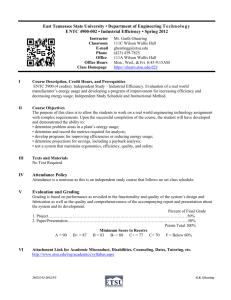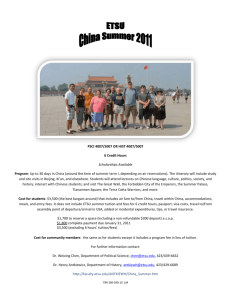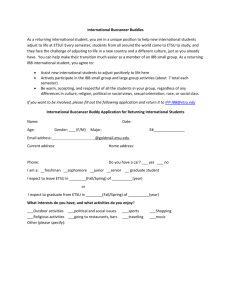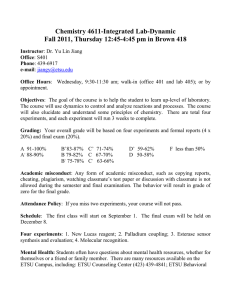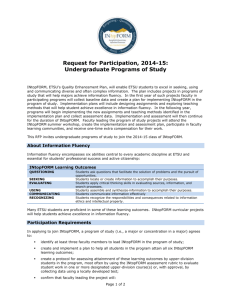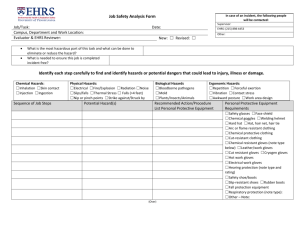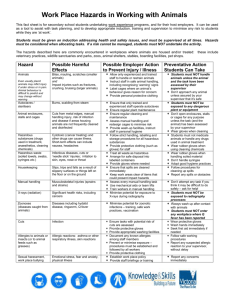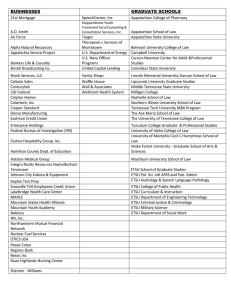Employee Safety Handbook i
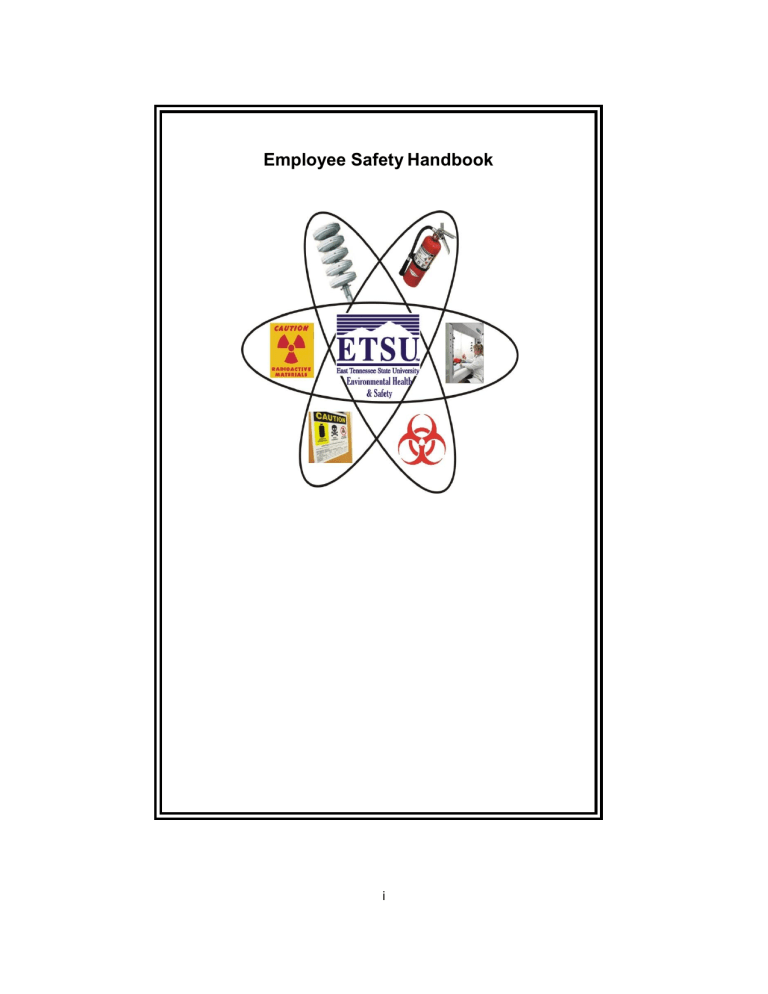
Employee Safety Handbook
i
Table of Contents
I. Introduction
Background ............ ........................ ............ .............. .......... .......... 1
Health and Safety Policy .................. ............ .............. .......... ............ .......... 1
Health and Safety Responsibilities .. ............ .............. .......... ............ .......... 1
Employees Responsibilities ............. ............ .............. .......... ............ .......... 1
Supervisors Responsibilities ............ ............ .............. .......... .......... 2
Unit Heads Responsibilities ............. ............ .............. .......... ............ .......... 2
Health and Safety Office .................. ............ .............. .......... ............ .......... 2
University Safety Committee ........... ............ .............. .......... ............ .......... 3
II. Safety Practices
Communication of Hazards in the Workplace .............. .......... .......... 3
Personal Protective Equipment (PPE) .......... .............. .......... ............ .......... 3
Eye and Face Protection ................. ............ .............. .......... ............ .......... 4
Hand/Arm and body Protection ........ ............ .............. .......... ............ .......... 4
Head and Foot Protection ................ ............ .............. .......... ............ .......... 5
Hearing Protection .. ........................ ............ .............. .......... ............ .......... 5
Respiratory Protection ..................... ............ .............. .......... ............ .......... 5
Documentation........ ........................ ............ .............. .......... ............ .......... 6
Training ...... ............ ........................ ............ .............. .......... ............ .......... 6
General Safety Rules ....................... ............ .............. .......... ............ .......... 6
Safe Handling of Laboratory Glassware ....... ............ ............ ............ .......... 7
Emergency Preparedness Procedures ......... ............ ............ ............ .......... 7
When the Fire Alarm Sounds ........... ............ ............ ............ ............ .......... 8
Employee Accidents ........................ ............ ............ ............ ............ .......... 8
Student or Visitor Accidents ............. ............ ............ ............ .......... 8
Automobile Accidents ...................... ............ ............ ............ ............ .......... 8
III. Health and Safety Program Checklist
Health and Safety Programs ............ ............ ............ ............ ........ 10 ii
Employee Safety Handbook
I. Introduction
Welcome to East Tennessee State University. The skills and talents you bring to ETSU are vital to our mission of teaching, research and service to the region and state. One of the keys to accomplishing that mission is to ensure that we maintain a safe and healthy campus environment.
This Employee Safety Handbook is intended for ETSU employees, full time and part time, regular and temporary, and all other ETSU employment categories, i.e., student workers, etc. The Handbook has been developed to provide employees with answers to general questions concerning health and safety in the workplace. It is important, however, that you and your supervisor discuss site-specific safety policies and programs for your department. Your supervisor must inform you of the safety procedures and required training you will need to do your job. The university’s policies, procedures, manuals, and many other safety resources may be found on the Health and Safety web site
(www.etsu.edu/healthsafety) or by contacting Health and Safety, 439-6028.
Background
In an effort to improve the overall working environment and to provide, insofar as possible, every working person in the nation safe and healthful working conditions, the
Federal Occupational Safety and Health Act of 1970 was enacted. This Act provided an opportunity for the various states to develop their own Occupational Safety and Health
Programs. In Tennessee this was accomplished by the Tennessee Occupational Safety and Health Act of 1972, administered by the Tennessee Department of Labor. East
Tennessee State University, as a state university, is administered by the Public Sector
Programs Department. They may be contacted at 800-249-8510.
Health and Safety Policy
East Tennessee State University strives to provide a safe and healthful working/learning environment for its students, faculty, staff, and visitors. ETSU strives to play a leadership role in its environmental stewardship, health protection, safety standards and in its compliance with applicable laws and regulations. The achievement of these goals is an objective for units at all levels of the institution. Employees and students are expected to be supportive of these goals in their university activities.
Health and Safety Responsibilities
Good environmental health and safety practices are a responsibility of all ETSU employees. The participation and cooperation of each person is essential to a smooth and effective program.
Employees Responsibilities
Your responsibilities as an ETSU employee include:
· Following all health and safety rules and procedures;
· Reporting hazardous conditions to your supervisor;
· Wearing or using prescribed protective equipment;
· Reporting any job-related injury or illness to your supervisor and seeking
2
Employee Safety Handbook treatment promptly; and
· Refraining from the operation of any equipment without both proper instructions and authorization.
Supervisor’s Responsibilities
Each supervisor is responsible for providing a working environment free from recognized health and safety hazards. Specific safety responsibilities of supervisors include:
· Informing new employees of their health and safety responsibilities, procedures, rules and regulations;
· Assuring that required equipment and personal protective devices are provided, maintained, and used;
· Taking prompt action when unsafe acts or conditions are reported or noted;
· Providing for health and safety training and education on a continuing basis;
· Investigating and reporting all on-the-job accidents promptly and requesting medical treatment if necessary;
· Investigating and reporting all job-related health or safety problems promptly;
· Coordinating or conducting internal inspections to assure safe and healthful working conditions;
· Requesting the assistance of the next higher level of supervision regarding budget requests for any health and safety improvements needed; and
· Ensuring their employees are made aware of their rights under the Tennessee
Occupational Safety and Health Act of 1972. The State of Tennessee Public
Employee, Safety and Health Protection on the Job poster is the authorized means of providing this information. The poster, available from Health and
Safety, should be posted in each ETSU department.
Unit Head’s Responsibilities
Deans, Directors, Chairs and other heads of academic and administrative units have primary responsibility for:
· The health and safety of their staff and students;
· Compliance with all applicable laws and regulations; and
· Obtaining and providing funds needed for health and safety improvements and for making those improvements;
· Requirements and responsibilities established by agencies external to the university.
Health and Safety Office
Health and Safety is responsible for development, oversight, and management of environmental health and safety programs that protect the environment, provide safe and healthy conditions for work and study, and comply with applicable laws and regulations.
Health and Safety provides educational programs, technical assistance, and health and safety services to the university community. The office also functions as a consultant to deans, directors, and heads of academic and administrative units, other staff members,
3
Employee Safety Handbook and students in all areas of environmental health and safety. The Health & Safety Office makes health and safety investigations as necessary.
University Safety Committee
The Standing University Safety Committee is responsible for:
· Recommending policies and programs to insure a safe environment for students, staff, faculty, and visitors on campus, except in areas delegated to other bodies, i.e., Bio-Safety;
· Monitoring the campus to ensure that university safety policies, procedures, and facilities are in compliance with applicable, state, and/or local code requirements;
· Reviewing, evaluating, and recommending for approval university Emergency
Preparedness plans.
The Committee reports to the President through the Vice President for Business and
Finance.
The Committee voting membership includes one faculty representative from
Environmental Health, Public Health, and Technology; one staff representative; one representative from VPs of Academic Affairs, Health Affairs, and Student Affairs; two student representatives and Vice President for SGA.
The Committee non-voting and ex-officio membership includes the Director of Health and
Safety; Associate Director of Physical Plant; Director of Public Safety; Director of Human
Resources; Director of Physical Plant and Director of Disability Services.
II. Safety Practices
Communication of Hazards in the Workplace
Faculty, staff, and students must be informed of any recognized hazards in their workplace. It is the responsibility of supervisors to provide adequate health and safety orientation related to standard operating procedures, hazards, and personal protective equipment. You should receive this orientation prior to working in the area.
Please make sure you understand all information presented at the orientation. If you have any language barriers, please explain these to your supervisor. Your supervisor must ensure that all applicable policies affecting your work place is readily available.
Personal Protective Equipment (PPE)
Faculty, staff, and students may be required to wear PPE while performing their jobs, i.e., welding, asbestos removal, painting, etc. or when they are in certain environments (for example, chemical laboratories). Your supervisor will tell you the specific PPE you must wear and ensure that you know when it must be worn. The following is a general guide for selecting what may be necessary. Additional information may be found in the ETSU
Personal Protective Equipment Program (under construction).
4
Employee Safety Handbook
Eye and Face Protection
Proper eye protection reduces your chances of injuring and reduces the security of injuring if an accident does occur. Most workers who have had eye injuries were not wearing eye protection at the time.
All eye and face protective equipment must comply with the American National Standards
Institute (ANSI) guidelines and be marked directly on the piece of equipment. Protective eye wear includes safety glasses, gaggles and face shields.
Operations listed below are a few examples where eye and face protection may be required:
· Handling acids or caustics.
· Welding.
· Woodworking, i.e., sowing, drilling, sanding, etc.
· Metal working.
· Chiseling.
· Metal casting.
· Handling solvents.
· High pressure washing.
· Handling human tissue, blood, or other bodily fluids.
· Using Lasers
Chemical hazards – To protect the eyes and face from plash when handling bodily fluids, using or dispensing corrosive liquids, non-vented chemical goggles or safety glasses with side shields and full-face shield offer the best protection. Safety glasses are the minimum protection recommended of all operations involving hazardous chemicals.
Physical hazards – When using high-pressure cleaning or spray equipment, safety glasses with side shields and full-face shields are the recommended PPE.
Those work activities that produce chips or dust —such as grinding/drilling, power fastening, or power tools —require safety glasses with side shields as a minimum protection level and in some instances may also require the use of a full-face shield.
Welding – Welding operations require a full welding hood with the appropriate tinted vision screen. Safety glasses with side shields are also required to be worn under the hood.
When doing acetylene oxygen torch soldering, brazing, or cutting, appropriately tinted safety glasses with side shields or tinted goggles are the appropriate PPE.
Hand/Arm and body Protection
Almost 75% of workers who suffered hand injuries were not wearing gloves. Although no glove will offer you total protection from every hazard, wearing the correct glove will help you prevent hand injury. Make sure the glove(s) you use in your work area are designed
5
Employee Safety Handbook to protect against the particular hazard(s) that have been identified.
The following are general guidelines in selecting and using gloves:
· Use metal mesh or cut resistant gloves to prevent cuts from broken glassware, knives or sharp other objects.
· Use leather gloves for mechanical or where repetitive motions are involved to prevent blisters, calluses, and abrasions. Leather gloves also protect against rough surfaces, sparks, and moderate heat.
· Use cotton or other fabric gloves to protect against dirt and dust, or to better grasp slippery objects.
· Use rubber, neoprene, vinyl, or nitrile gloves to protect against chemicals.
· Workers who are sensitive to natural rubber latex should avoid direct contact with latex gloves and other rubber products.
· Check gloves before wearing to make sure they’re not cracked, torn, or damaged in any way.
· Make sure gloves fit properly. They should cover your hands completely and be comfortable enough for you to perform your job.
· Take care to avoid contamination —don’t let your bare skin touch contaminated gloves.
· Dispose of single-use gloves in the proper containers.
When using hazardous chemicals, specialized gloves offering protection for specific chemical families, a laboratory coat, and at times a splash apron are the appropriate
PPE.
Insulated gloves and arm sleeve covers are recommended when handling hot or cold materials.
Head and Foot Protection
Occasions may develop during the work day or job duty when the use of a hard hat or other head protection and foot protection is necessary. All hard hats or safety shoes must meet the requirements for protection outlined by the American National Standards
Institute (ANSI).
Hearing Protection
If your work areas or specific job tasks have been designated as requiring hearing protection, you must wear approved protective equipment. Personal stereos or
Walkman’s® are not considered approved hearing protection. If you have questions about high noise levels in your work area, you should ask your supervisor or contact the
Health and Safety Office for more information.
Respiratory Protection
Some employees are required to wear respirators for specific job duties. Respirators include dust masks, air-purifying negative-pressure respirators, self-contained breathing
6
Employee Safety Handbook apparatus, supplied-air respirators, and other such devices. If you wear one of these respirators, you must have a physical exam and you must be ―fit tested‖ and trained before using it on your job.
Documentation
Supervisors are responsible for maintaining written copies of safety programs and employee training documentation. This documentation is a requirement of most regulatory standards. Regulatory agencies may ask to see these documents during an inspection.
Training
You may be required to attend in-house training sessions on such topics as bloodborne pathogens, hazard communication, hazardous waste, asbestos awareness, or laboratory safety. Supervisors of affected employees should exercise a measure of accommodation for these needing training. A checklist to help you understand which ETSU Health and
Safety programs apply to you may be found on page 9.
In some cases, supervisors may conduct specialized training sessions (e.g., safety procedures for using powered equipment). Supervisors can contact the Health & Safety
Office for information or assistance in preparing training materials. Specialized training, e.g., forklift, asbestos awareness may be provided by outside training consultants.
Training should be provided:
· When an employee is hired, when an employee is given a new work assignment for which training has not previously been given; and
· When a new hazard (chemical or physical) is introduced into the workplace.
At a minimum, health and safety training for employees must include:
· Recognition of health and safety hazards;
· General and job-specific health and safety practices; and
· State regulations and ETSU health and safety policies applicable to the job.
General Safety Rules
· All classrooms, laboratories, offices, shops, storerooms, and passageways will be kept orderly and free from unnecessary debris.
· Floors will be cleaned and waxed in such a manner as to keep slipping hazards to a minimum.
· Flammable liquids will not be used to clean floors, clothing or equipment.
· Trash containers in offices, laboratories, shops and other work areas will be emptied each working day, preferably at the end of normal working hours, or thereafter.
· Furnace, mechanical, and air handling rooms will not be used as storage areas.
7
Employee Safety Handbook
· Worktables, stools, benches, tools and equipment will be maintained in good repair.
· Electrical and mechanical equipment will have moving parts adequately guarded.
· All electrical equipment will be properly grounded.
· Appropriate personal protective equipment and/or clothing will be worn in all areas and/or during operations requiring such use.
· Unauthorized persons will not tamper with electrical fuse boxes, alter existing wiring, or install new electrical wiring.
· Electrical cords will be maintained in good condition.
· Extension cords must be the type that contain a built-in overload circuit breaker, they must not be extended and used outside the room in which the fixture outlet is located, and must not be located in such a manner as to create a tripping hazard. Where cords must be placed across paths of travel, cord covers must be used.
Safe Handling of Laboratory Glassware
Supervisors in departments that use glassware, must develop procedures to handle all glassware safely and ensure that all employees and/or students are informed of these procedures. Areas that should be addressed include:
Glassware inspection;
Compatibility factors;
Effects of extreme temperatures and pressure;
Matching glassware to its intended use;
Use of Personal Protective Equipment;
Storage and handling;
Washing and clean-up;
Assembling apparatus;
Safe disposal of broken or disposable glassware.
Emergency Preparedness Procedures
The establishment of well thought out emergency plans is one of the cornerstones of an effective safety program. Evaluating potential emergency situations, developing emergency procedures, and conducting practice exercises can help save lives. Detailed instruction regarding emergency procedures may be found in the ETSU Emergency
Preparedness Plan.
An ETSU Emergency Desk Reference has been prepared and distributed to all employees. The desk reference which should be kept readily available in your work area provides useful information pertaining to severe weather, fire and bomb threats.
You should become familiar with the posted evacuation plan and how you should respond to a fire or other emergency in your building and be prepared to evacuate the building when necessary.
When the Fire Alarm Sounds
8
Employee Safety Handbook
If you are in any ETSU building and discover a fire, please take the following actions:
· Leave the building immediately.
· Pull the nearest fire alarm pull station and notify Public Safety, 911.
· Leave the area quickly, closing doors as you go to contain the fire and smoke.
· If you encounter smoke or flame during your escape, use an alternative exit. If you must exit through smoke, crawl on your hands and knees.
· Do not re-enter the building until emergency response officials have declared that it is safe to do so.
In the event of a serious injury requiring immediate medical assistance or any other emergency, remain calm, call 911, notify the dispatcher of the type and location of the emergency, answer any questions the dispatcher may have and stay on the line until released by the dispatcher.
Employee Accidents
You must report all work-related accidents, injuries, or illnesses to your supervisor. If an injury or illness requires medical attention, supervisors must report them to Human
Resources, 9-7089.
The supervisor must complete an OSHA Form 101, Supplementary Revised of
Occupational Injury or Illness, and forward it to Human Resources, Box 70564, within two working days. This form may be completed over the phone or faxed to 9-8354 followed by a hard-copy. Forms are available at Human Resources or may be downloaded from the Health & Safety Website.
Student or Visitor Accidents
Any faculty or staff member who witnesses, is involved in, or is informed of an accident with a student or visitor should report the accident to Public Safety, 9-4480.
Automobile Accidents
All vehicle accidents occurring on campus will be reported to Public Safety 9-4480, who will notify other offices or officials as appropriate.
All accidents involving State vehicles must also be reported to the Comptroller, 9-5600, and the Physical Plant, 9-7900.
III. Health and Safety Program Checklist
The following checklists have been developed for you and your supervisor to understand the hazards and applicable Health and Safety Programs associated with your workplace st or assigned duties. If you answer yes to questions in the 1 column, then the corresponding ETSU program and training requirements are, most likely applicable.
Training may be provided by your supervisor, designated staff, Health and Safety, or outside vendors. Training must be provided and documented before performing any of the listed activities.
9
Employee Safety Handbook
Checklist for Work Areas
Activity
Are there hazardous chemicals in your work area?
Applicable Program
Hazard Communication Program
Do you work with hazardous chemicals?
Hazardous Waste Management Guide
Do you provide first aid services or do you work with human blood, body fluids or tissues?
Does your work require hearing protection?
Do you use or service equipment for which an unexpected restarting could cause injury?
Bloodborne Pathogen Program
Hearing Conservation Program
Lockout-Tagout Procedures
Under Construction
Are you required to enter any confined spaces?
Do you operate industrial trucks (e.g., forklift, bucket truck, etc.)?
Do you use work in a laboratory that uses infectious agents, human blood or tissue, bodily fluids or other biohazards?
Confined Space Program
Under Construction
ETSU Forklift Operator’s License is required
Do you use respirators of any kind
(including dust masks)?
Respiratory Protection Program
Under Construction
Does your area have fire extinguishers?
Emergency Preparedness Plan
Do you use work in a laboratory that uses
ETSU Emergency Desk Reference
Chemical Hygiene Plan hazardous chemicals?
Hazard Communication Program
Hazardous Waste Management Guide
Bloodborne Pathogen Program
Radiation Safety Manual Do you use work in a laboratory that uses radioisotopes?
Do you conduct research that involves the use of animals?
ETSU Occupational Health Program for Personnel with Vertebrate Animals
Contact.
Lockout-Tagout Procedures
Under Construction
Do you use or service equipment for which an unexpected restarting could cause injury?
10
Employee Safety Handbook
Health and Safety Programs
Health & Safety has developed a number of model programs to help provide for the health and safety of
ETSU employees. Many of these programs are mandatory to ensure compliance with state and federal regulations. The following are some of the programs and safety manuals available:
Bloodborne Pathogens Program
Emergency Preparedness Plan
Hazard Communication Program
Hazardous Waste Manual
Laboratory Safety Manual (Chemical Hygiene Plan)
Lockout/Tagout Program
Personal Protective Equipment Program and Hazard Assessment
Radiation Safety Manual
Respiratory Protection Program
Confined Space Entry Program
Hearing Conservation Program
For copies of these manuals or programs, contact the Health & Safety Office. These and other safety resources are also available on the Health & Safety web site.
A copy of the Employee Safety Handbook has been given to me at the time of my employment.
I promise to read the contents and to ask for an explanation of any parts that I do not understand. The Employee Safety Handbook describes important information about ETSU, and I understand that I should consult the Environmental Health & Safety Department or my supervisor regarding any questions not answered in this Handbook.
Since the information, policies and procedures described here are subject to change, I acknowledge that revisions to the Handbook may occur. Only the Environmental Health &
Safety Department is authorized to adopt any revisions to the policies in this Handbook.
Signature__________________________________________Date____________
11
